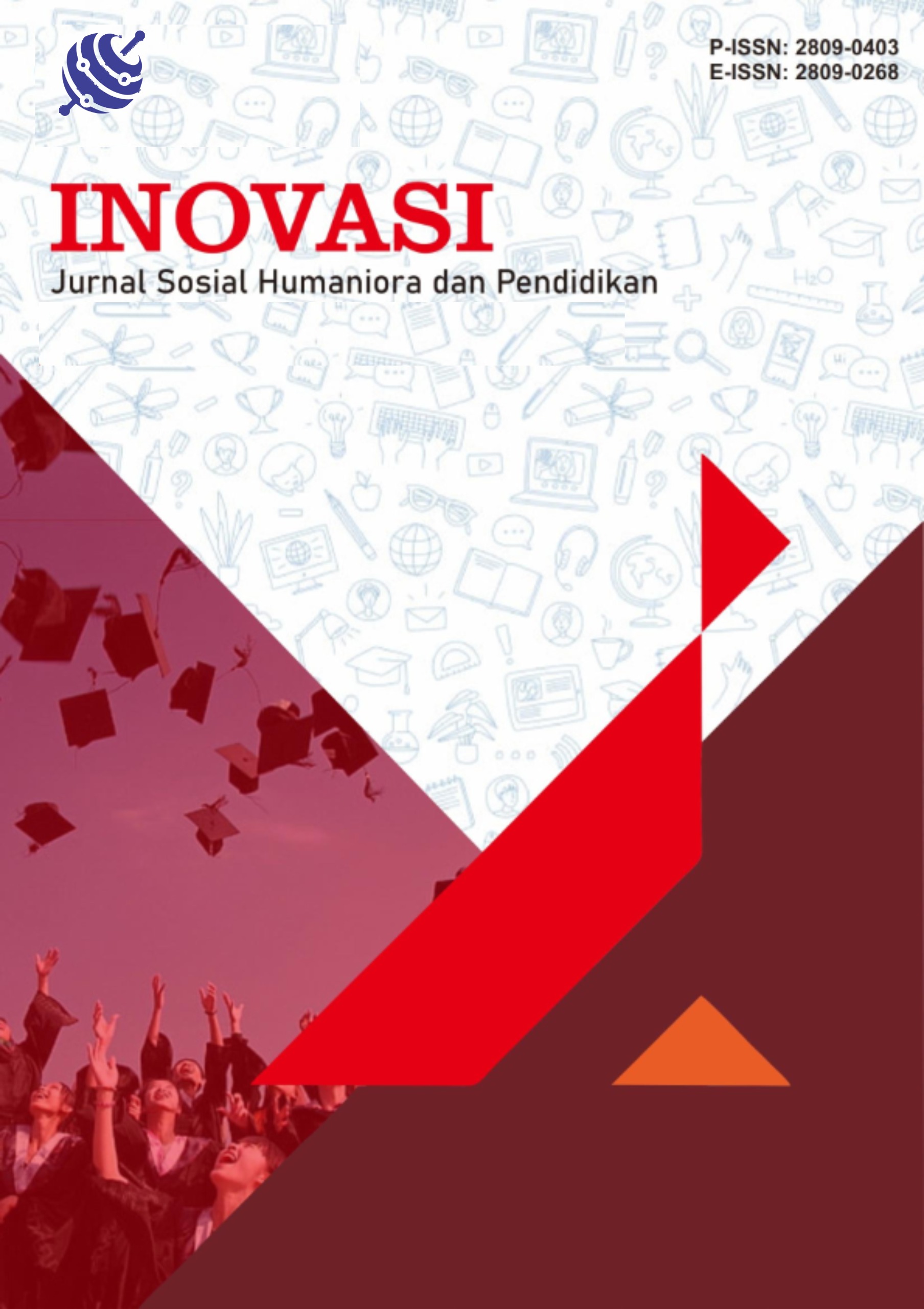The Influence of Tri-Nga Integrated Deep Learning Approach on Students' Conceptual Understanding and Learning Motivation
DOI:
https://doi.org/10.55606/inovasi.v4i1.4299Keywords:
Deep Learning, Concept Understanding, Student Learning MotivationAbstract
Education is a conscious and planned process to create a learning atmosphere and learning process so that students actively develop their potential, both in terms of intellectual, spiritual, social, and skills, so that they become individuals with character and are able to contribute to community life. This study aims to test the hypothesis of the effect of the Tri-Nga integrated Deep learning approach on the understanding of concepts and learning motivation of fifth grade students in Mathematics Education. The population of this study was all fifth grade students at SD Kalikotes District, Klaten Regency which consists of 6 schools. The number of fifth grade students is 243 students. The type of research used by the researcher is quasi-experimental research or pseudo-experiment. The data collection technique used is observation and pretest posttest in the form of multiple choice to measure conceptual understanding and essay questions to measure student learning motivation. The data analysis technique used in this study is descriptive analysis and statistical analysis. The results of this study concluded that the data obtained from the analysis using the Manova test, showed that there was a significant difference in the ability to understand concepts and learning motivation of fifth grade students in Mathematics after the implementation of the Tri-Nga integrated Deep Learning teachings approach. This is indicated by the Hotelling's Trace significance value of 0.007 for conceptual understanding and 0.000 for learning motivation, both of which are below the significance level of 0.05. Students who follow learning with this approach show better conceptual understanding and higher learning motivation than students who do not use it. This increase occurs because the Tri-Nga integrated Deep Learning approach is able to encourage students to understand the material in depth (ngerti), feel the meaning of learning (ngrasa), and apply it in real life (nglakoni), so that they become more active, motivated, and easy to solve learning problems.
References
Almulla, M. A. (2020). The effectiveness of the project-based learning (PBL) approach as a way to engage students in learning. SAGE Open, 10(3), 215824402093870. https://doi.org/10.1177/2158244020938702
Apriani, & Wangid. (2015). Implementation of digital-based differentiated learning in analyzing the structure and language of procedural texts. Journal of Elementary Education Didactics, 8(2), 533–558. https://doi.org/10.26811/didaktika.v8i2.1280
Astuti, N. D., & Octaviani, S. (2023). Improving mathematics learning outcomes through a realistic mathematics learning model based on Bruner's learning theory. Journal of Education and Teaching Review, 6(2), 1–5.
Chotim, A., Susanti, I. N., & Aryani, D. N. (2016). The effect of project-based learning model on the cooperation ability of 5–6 year old children at Saiwa Dharma Banyuning Kindergarten in the 2015/2016 academic year. Bioscientist: Scientific Journal of Biology, 11(2), 908. https://doi.org/10.33394/bioscientist.v11i2.8405
Gunarsa. (2013). Improving problem solving ability in mathematical story problems through realistic mathematics learning in grade IV students of SD Negeri Baturan 2 Gamping Sleman. Jurnal Elementary, 5(2), 163. https://doi.org/10.31764/elementary.v5i2.9079
Juliani, A., Mustadi, A., & Lisnawati, I. (2021). "Make a Match Model" for improving the understanding of concepts and student learning results. Journal on Learning and Advanced Education, 3(1), 48–56. https://doi.org/10.23917/ijolae.v3i1.10269
Karmila, W., Achmad, S., Aulia, N. R., & Makassar, U. N. (2024). The effect of using the Quizizz application on student learning outcomes in the subject PPKn class IV SDN Melay. Indopedia Journal (Learning and Education Innovation), 2, 464–476.
Latif, N. S. (2022). Efforts to increase students' motivation to learn mathematics through e-learning assisted by Quizizz. BARUGA: Scientific Journal of BDK Makassar, 11(2), 1–14.
Magdalena, I., Haq, A. S., & Ramdhan, F. (2020). Civic education learning in Bojong 3 Pinang State Elementary School. Journal of Education and Science, 2(3), 418–430. https://ejournal.stitpn.ac.id/index.php/bintang
Masnur. (2017). Effectiveness of differentiated learning implementation in elementary school students' PPKn subject content. Basicedu Journal, 7(2), 1315–1321. https://doi.org/10.31004/basicedu.v7i2.4978
Nafiah, T., Yulia, Y., Muti’ah, T., & Khosiyono, B. H. C. (2024). Implementation of differentiated learning to accommodate students' learning needs. Journal of Elementary Education SINTA, 8(2).
Nurhakiki, J., Yahfizham, Y., William, J., Ps, I. V., Estate, M., Percut, K., Tuan, S., & Serdang, K. D. (2024). Literature study: Introduction to 4 algorithms in deep learning and their implications. Jurnal Pendidikan Berkarakter, 1, 270–281. https://doi.org/10.51903/pendekar.v2i1.598
Purwanto. (2017). Analysis of the effectiveness of realistic mathematics approach to improve students' mathematics learning motivation. EduMatSains: Journal of Education, Mathematics and Science, 7(2), 355–362. https://doi.org/10.33541/edumatsains.v7i2.4553
Putri, R. (2024). Educational innovation using deep learning models in Indonesia. 2(2), 69–77.
Raup, A., Ridwan, W., Khoeriyah, Y., Supiana, S., & Zaqiah, Q. Y. (2022). Deep learning and its application in learning. JIIP - Scientific Journal of Educational Sciences, 5(9), 3258–3267. https://doi.org/10.54371/jiip.v5i9.805
Silva, A. B. da, Bispo, A. C. K. de A., Rodriguez, D. G., & Vasquez, F. I. F. (2018). Problem-based learning: A proposal for structuring PBL and its implications for learning among students in an undergraduate management degree program. Revista de Gestão, 25(2), 160–177. https://doi.org/10.1108/REGE-03-2018-030
Sofiana, A. I., Sulistiani, I. R., & Mustafida, F. (2024). This work is licensed under Creative Commons Attribution Non Commercial 4.0 International License. Jurnal Pendidikan Madrasah Ibtidaiyah, 6. http://riset.unisma.ac.id/index.php/JPMI/index
Sulistyorini. (2014). Student learning motivation towards mathematics learning outcomes. Plusminus: Journal of Mathematics Education, 3(1), 29–38. https://doi.org/10.31980/plusminus.v3i1.1220
Sumarni, W., Wardani, S., Sudarmin, S., & Gupitasari, D. N. (2016). Project-based learning (PBL) to improve psychomotor skills: A classroom action research. Indonesian Journal of Science Education, 5(2), 157–163. https://doi.org/10.15294/jpii.v5i2.4402
Wahyuni, A. S. (2022). Literature review: Differentiated approach in science learning. Journal of Mathematics and Natural Sciences Education, 2(12), 118–126.
Downloads
Published
How to Cite
Issue
Section
License
Copyright (c) 2025 Jurnal Sosial Humaniora dan Pendidikan

This work is licensed under a Creative Commons Attribution-ShareAlike 4.0 International License.







